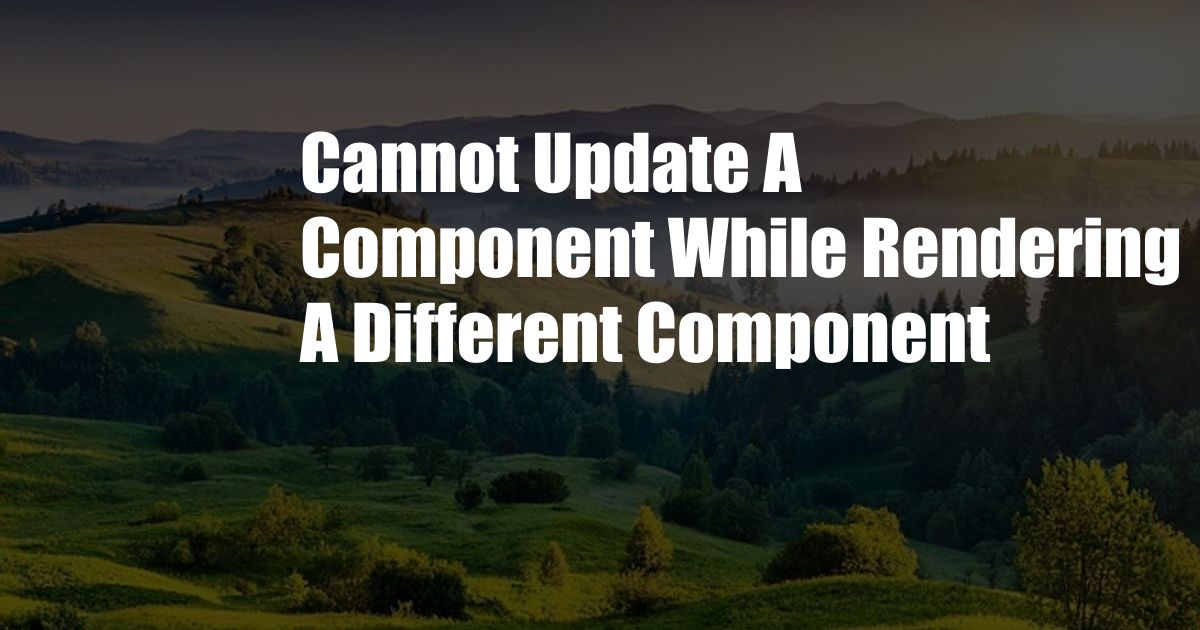
Cannot Update a Component While Rendering a Different Component
Suppose you are familiar with React, a popular JavaScript library for building user interfaces, you may have encountered a common error: “Cannot update a component while rendering a different component.”
This error message occurs when a component is updated while it is in the middle of rendering. Because React has a one-way data flow, updates to the component’s state or props should only occur before or after the rendering process. If an update occurs during rendering, it can lead to unexpected behavior and errors.
Avoiding the Error
To avoid this error, ensure that updates to components occur outside the rendering cycle. This means that state and props should be updated in the componentDidUpdate lifecycle method or by using the setState method with a callback function. Additionally, avoid making direct changes to the state or props during rendering, as this can trigger an immediate update and potential errors.
Understanding the Root Cause
When a component is updated during rendering, it can cause inconsistencies in the React state. This is because React uses a virtual DOM to efficiently update the user interface. If the state changes during rendering, the virtual DOM may not accurately reflect the intended state of the component, leading to potential errors and unexpected behavior.
To prevent these inconsistencies, React enforces a one-way data flow, where state updates should occur before or after the rendering cycle. This ensures that the virtual DOM remains in sync with the intended state of the component, resulting in a consistent and reliable user interface.
Best Practices for Updating Components
Follow these best practices to avoid the “Cannot update a component while rendering a different component” error:
- Update state and props in the
componentDidUpdatelifecycle method. - Use the
setStatemethod with a callback function to update state after rendering. - Avoid modifying state or props directly during rendering.
- Use React’s built-in state management tools (e.g.,
useState,useEffect) to ensure proper state updates.
Expert Advice
Expert React developers recommend following these additional tips:
- Use a linter like ESLint to detect potential errors and enforce best practices.
- Test your components thoroughly to identify and resolve potential issues.
- Stay up-to-date with the latest React updates and best practices by referring to the official React documentation and community resources.
By following these guidelines, you can effectively handle component updates in React and avoid the “Cannot update a component while rendering a different component” error, resulting in robust and reliable user interfaces.
FAQs on Component Updates in React
Q: Why does React prevent updating a component while rendering a different component?
A: To maintain consistency in the React state and avoid unexpected behavior due to inconsistencies in the virtual DOM.
Q: How can I avoid this error?
A: Update state and props in the componentDidUpdate lifecycle method or using the setState method with a callback function.
Q: What are some best practices for updating components in React?
A: Use React’s built-in state management tools, avoid direct state or props modification during rendering, and thoroughly test your components.
Conclusion
Understanding the “Cannot update a component while rendering a different component” error is crucial for effective React development. By adhering to best practices and expert advice, you can ensure proper component updates, avoid errors, and enhance the user experience. Embrace these guidelines to become a proficient React developer and build robust and reliable user interfaces.
Are you experiencing this error or have other questions related to component updates in React? Let us know in the comments below, and we’ll be happy to assist.